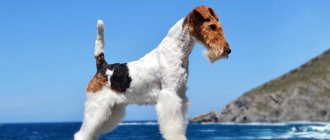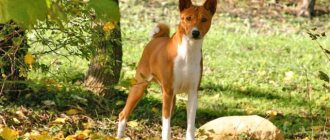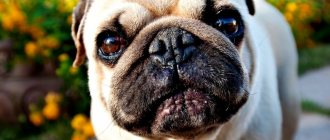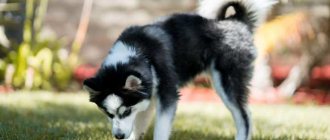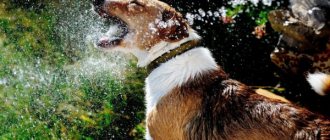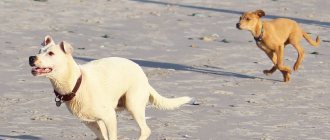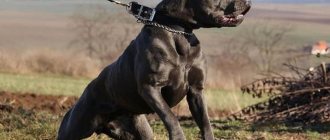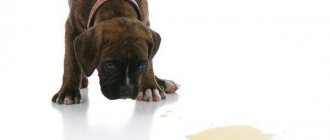The decisive factor before bringing a dog into the house or not is the presence of a specific smell. If you plan to have an animal in a private home, as a rule, the smell from the dog does not bring much discomfort.
If you plan to have an animal in an apartment, the presence of the smell from the pet is a decisive factor. There is no need to despair, as there are a number of dog breeds that do not have a specific odor.
In addition, with properly organized care, the problem can be prevented or eliminated. Timely bathing, brushing teeth and ears, as well as using special animal care products will help avoid the appearance of an unpleasant dog odor in the apartment.
Yorkshire Terrier
The pets are quite positive and are suitable for keeping in a family where the child is over 7 years old. Yorkies belong to the group of indoor and decorative breeds. Dogs were bred specifically for close coexistence with humans, so they have almost no smell. If unpleasant odors do appear, there are several reasons for this:
- inflammation of the paraanal sinuses;
- bacterial infection;
- fungus;
- poor hygiene;
- diseases of teeth and gums.
The condition of the eyes, ears, and mouth should be checked. The best option is to show the animal to a specialist.
Hypoallergenic
Portuguese merman
Excellent proof that even a large animal can not smell or shed. In addition, Portuguese waterweed is the most hypoallergenic , i.e. does not cause allergies in people. This is a large, muscular black and white animal with thick and water-repellent fur. It was bred in Portugal in order to transmit messages from ship to ship and drive fish into nets, as a result of which it is very smart .
It is easy to train, but at the same time it is willful: it will listen to its owner only if it considers that there is something to respect him for.
You should not get a Portuguese merman if you have no experience raising dogs before: it will not obey.
Better choose a dog from this list: 11 dog breeds for a beginner: the best first pet for you .
You shouldn’t have her even if you are busy all the time: she has a hard time with loneliness and suffers without her owner. The coat will have to be brushed daily, but there will be no problems with feeding. It is better to feed homemade food. By the way, a dog of this particular breed, Bo, lived with President Barack Obama.
Shih Tzu, or miniature lion
Indeed, this breed of dog was bred in China, at the court of the emperor, and the name is translated from Chinese as “lion cub.” Externally, the dog somewhat resembles a lion, but very small, shaggy and multi-colored. There are combinations of red and white, white and black or brown.
A very loyal and friendly dog that does not smell and (very little) practically does not shed. The wool falls out only during the combing process. In addition, it does not cause allergies in most sufferers .
You need to understand that, despite the external decorativeness, this animal cannot be a “couch decoration”. He will relentlessly follow his owner and need his love and affection . Even when your Shih Tzu is sound asleep, he will wake up and run after you if you go into another room.
The advantage of Shitzs is that they can be used to create different hairstyles.
But the dog can easily manage without walks outside. Needs regular brushing. The food is normal, but you need to keep an eye on the animal when it drinks water: due to the structure of its nose, water can completely block its breathing.
7 Best Dog Breeds for Lazy Owners
Maltese
Another snow-white baby that won’t leave a single hair on your furniture or clothes. The dog was bred in ancient Rome as a companion for women. Also used for hunting rodents. The lapdog has an excellent character : at the same time playful and affectionate, perky and gentle. Allergies (as a rule) do not occur to the wool of this breed, for this reason the Maltese is the best option for allergy sufferers.
An intelligent and curious animal that will loyally protect its owner and, if necessary, bite the offender. It is not advisable for children to have this breed .
The main difficulty in grooming is the long, thick and pleasant-to-touch coat, which will have to be constantly washed and combed. The weak point is the eyes and lungs; lap dogs also often suffer from asthma. Therefore, before purchasing, you should familiarize yourself with the medical records of the animal’s parents.
To avoid the hassle of combing, you can give your dog a stylish haircut
What a beauty!
You need to feed her dry food, otherwise an upset stomach will inevitably occur.
The most hypoallergenic dogs: 19 breeds that do not cause allergies in humans
Brussels griffin
Representatives of the breed were bred in Belgium. In the vastness of Russia, this breed is not very popular. People first started talking about it at the beginning of the 19th century. Initially, dogs were kept in the yard. They were supposed to catch rodents. Over time, griffins began to be kept at home. Dogs are very smart, well trained, and quickly find a common language with humans and other animals. This is a great option for families with children.
They don't smell
If you answered yes to this question, congratulations: most odorless breeds are also not prone to shedding. So, by choosing a pet from this list, you will get a creature that loves you devotedly, who will not stink and leave its fur everywhere.
So, here is a list of breeds that do not shed and do not smell:
Chinese Crested
This beauty was bred in ancient China, hence the name. There, this breed was an indicator of the status of the owner: only wealthy people could afford it. But they never parted with the crested cat anywhere, they even took it with them on voyages - and this is how the breed spread throughout the world. The animal’s head is indeed adorned with an unusual crest, which often becomes a source of pride for its owners: it is combed, decorated with bows and even curled.
There are two subtypes of the Chinese Crested: completely hairless, or with a little fur. Both varieties are odorless . When starting a crested cat, you need to take into account its characteristics.
This is the most odorless dog, moreover, friendly, very active and attached to the owner, which cannot remain alone in the apartment for a long time. Despite her decorative nature, the crested cat cannot do without walks - she needs to satisfy her curiosity. And in order to go for a walk with her, you will need a whole arsenal of clothes - the dog gets cold easily.
But if you take care of the animal, it will reward you with devotion and a lively mind: the crested one easily learns new tricks and can be trained. She also needs weekly bathing, shaving of the hair on her face if it starts to grow, and trimming of her nails. The diet is dry food with the addition of boiled vegetables and fruits.
Peruvian hairless
This is one of the most ancient breeds, which was bred back in the Inca era. The animal has a fur coat on its head, tail and legs, but otherwise has no hair. This dog is very graceful and beautiful, it is also called the “ Peruvian orchid ”. She is an excellent guard, equally attached to all family members, but needs constant attention: without it, the pet will begin to bark and whine. Moderately active, you can not walk with her often.
But she will need to be bathed after every walk; thin skin easily clogs pores and causes acne to appear . Fortunately, Sobaku described in detail the process of washing a pet in his article “Dirt fight: how often and with what can you wash a dog?” .
I just want to smile looking at this “punk”!
The animal is unpretentious in nutrition; dry food or homemade food is enough for it. You need to choose one thing; in the latter case, your diet must include boiled meat and vegetables.
Mexican naked
Another pet that is odorless and does not shed, from ancient times, which was bred by the Aztecs - their images can be found on wall paintings made 3000 years ago. True, the Aztecs did not really value the decorative features of dogs: they bred them for food and for ritual purposes. They also considered this breed capable of “taking away” any disease from a person.
Just babies
This is a very energetic dog that loves to play - preferably with its favorite owner, whom it chooses - and only one person. Gets along well with children, excellent with other pets, is open and sociable. At the same time, she has the character of a sanguine person; you can safely leave her alone in the apartment without fear of destruction.
Yes, yes, this is the same funny dog from the wonderful cartoon “The Secret of Coco”!
Demanding on nutrition : there must be boiled meat, beef and other low-fat varieties, vegetables and fruits. Fermented milk products should not be given. Your dog's teeth will require special care: they easily become inflamed and fall out. So you will have to brush your teeth daily . Also, the Mexican Hairless is sensitive to cold, easily catches colds and gets sick.
Step-by-step master class: how to brush your dog’s teeth
American Hairless Terrier
Bred in America in the last century, it is found in two varieties: miniature and rather large dogs. A distinctive feature is the complete absence of hair (with the exception of sideburns), soft skin with contrasting spots. The color can be almost any. Friendly and sociable, they get along well with other animals, especially cats . Excellent security guards.
The Hairless Terrier is considered a nanny dog that will always find a good language with children. Thanks to its reasonableness and moderate activity, this is an ideal dog for an apartment and a child .
You will find other breeds in the articles Four-legged friend: 34 dog breeds for children and Breeds of small dogs for an apartment: choosing a compact friend
The weak point of dogs of this breed is health . You need to take care of your skin by bathing and wiping with wet wipes between baths, wiping frequently watery eyes, trimming your nails, and applying anti-frostbite or sunburn cream.
The diet should also be special : 60% white meat, 25% cereals and vegetables, 10% dairy products. Prone to gastritis.
American pit bull
A fighting, but not aggressive dog. Outwardly, it is very similar to the Staff, but has a different muzzle structure and a kinder facial expression. Completely neutral in all respects by nature. It all depends solely on the upbringing and purposes for which the dog was purchased.
Can become a “nanny” for children or a faithful companion on walks or bike rides . It can develop high speed, so that it will not lag behind you. Doesn't chase cats or other cars, but may not get along with a domestic cat.
Only with proper adaptation and adoption into the family at an early age will he perceive other pets as friends.
Brussels griffin
Movie Star Dog: All animals of this breed have exceptionally expressive faces, which is why they are often chosen for filming. A small companion dog with reddish fur.
It gets along well with cats, but if you get it with a rat or hamster, tragedy will occur : the breed was originally bred to hunt rodents.
The griffin is irritated by children: they are too noisy for a dog. The dog of this breed is affectionate and intelligent, but capricious and stubborn. If there is a lack of upbringing, it will begin to control the owner.
The animal will need to be bathed, cut and combed weekly. It does not tolerate heat very well and is prone to eye diseases. It is better to feed dry food, carefully controlling portions: the griffin is prone to overeating and obesity.
Dalmatian
The Dalmatian is a charming, seemingly slightly reckless spotted dog. These spots are really randomly located throughout the body, even in the oral cavity. An interesting fact is that puppies are born completely white. The film “101 Dalmatians” made this breed especially popular. But life is not so fabulous and carefree. Keeping a Dalmatian is a real challenge, because it is a bundle of energy and lively emotions that, at times, are impossible to calm down.
This does not mean at all that the owner of this dog will be concerned about problems, but you need to be prepared for them. With proper upbringing and training, these cute dogs can become true friends. This is one of the few breeds that were bred as “carriage” dogs, that is, dogs that accompany the carriage, clearing its path.
It is difficult to tire a Dalmatian, and he must also experience physical activity every day (running, active games with a ball). They can accompany a bicycle running nearby for hours until the owner’s legs get tired
The Dalmatian does not smell at all, but sheds a lot!
The Dalmatian may suddenly feel like the head of the family, so it is very important to convey to him who is boss in the house. They are cunning manipulators and at the slightest indulgence they can hang a net around their neck with their paws dangling. However, they are extremely easy to train at home. They quickly bond with the owner and his family and become part of it. He may well jump into his owner’s bed, and if he is removed from an activity that all members of the family are passionate about, he will rage and show his dissatisfaction with all his appearance.
Shih Tzu
Dogs do not smell, behave quietly, and practically do not make sounds. Grooming requires significant financial investment. This must be understood before purchasing a four-legged friend. After each walk, you should wash your paws, comb your coat every day, and systematically clean your ears and trim your nails.
A separate point is brushing your teeth. Due to their specific bite, dogs are prone to developing infections.
They don't shed
Let's look at dog breeds that don't shed or smell.
West Highland White Terrier
This cute little cloud of white fur comes from Scotland. Initially, the breed was bred as a hunting breed for small game, foxes and badgers. To this day, a pet with this long name is able to crawl into any crack in your apartment - like into a badger hole.
Their fur is thick and two-layered, which protects animals from the cold. At the same time, the pet does not smell and practically does not shed. The baby's weight does not exceed 6-10 kilos, it is a very active, friendly and sociable dog. He will be a good companion and a vigilant guard .
Special care will be required for the coat : it must be constantly clean and not matted. You need to comb your pet twice a month. The baby also needs regular walks so that he has somewhere to burn off his energy. They are unpretentious in nutrition.
Poodle
There are three varieties: toy, miniature and standard. All three breeds are guaranteed to be odorless and non-shedding. The Poodle is a very smart and extremely active dog with curly soft fur and long legs.
Poodles were born in Germany, their German name “Pudel” literally meant “to splash in the water”, this once again reminds us of the hunting nature of the dog, which was bred to hunt birds. Regular poodles are the oldest representatives of the breed. Most often, it is these poodles who become the owners of extravagant haircuts.
By the way, today haircuts are performed for aesthetic purposes, but real dog lovers know that such hairstyles were invented to keep warm.
Despite their extravagant haircuts, poodles are far from fragile and shy animals. They lead a very sociable, friendly lifestyle. They love to run and play. The Poodle is a cheerful family dog that can play with children all day, and in the evening lie down near the fireplace or the owner’s bed.
These dogs do an excellent job of guarding. They do not bark without a reason, they can distinguish between “friends” and “strangers,” and they bark only when absolutely necessary . When danger arises, they do not hesitate to protect their owner and his family.
Poodles are highly trainable and learn new commands. They just pick things up on the fly. After the basic training course, you can move on to more complex tasks and teach him complex tricks.
She is easy to train and happily learns new tricks . In this case, the animal will need to devote a lot of time. Caring for a poodle to make it look good is a whole epic. It needs to be cut in a certain way, combed and washed.
Poodles are quite unpretentious in their diet, but in order not to put their health at risk, they should be fed a balanced diet. They have a sensitive liver, so fatty foods are excluded.
Greyhound
A slender and slender breed with a long, elongated muzzle. Can develop tremendous speed due to its long limbs. There are both “woolly” and smooth-haired representatives of this breed, however, none of them smell.
Behavior is calm, even passive. The aristocratic past makes itself felt, because this breed was at court and was considered very rare in Tsarist Russia.
Adaptation is difficult, you definitely need the help of a specialist . Generally does not do anything unless commanded or absolutely necessary. It easily makes contact only with rare breeds; with the correct influence of the owner, it can also make friends with “simple” breeds.
In general, their character is quite capricious, because they lived almost their entire history in greenhouse conditions, palaces, and houses of aristocrats. A beautiful and stately dog that can emphasize the status of the owner.
Boxer
A powerful and strong dog, born in Germany, combining courage, hot German temperament, kindness and loyalty to its owners. Due to his short fur, he does not emit that unpleasant “wet dog” smell.
The excretory system is designed in such a way that even under the most severe stress, dogs do not experience shortness of breath, much less sweating.
She loves children and pets, often plays with them, and can cheer them up if she feels in a bad mood. He will never refuse a walk, even when it’s raining outside. Such a dog needs to be washed once every 2-3 months, and even if this is not done, the unpleasant odor is barely perceptible.
Bichon Frize
The animals are distinguished by their affectionate, obedient character, and sometimes show independence. Very intelligent, playful animals. They are not afraid to establish contact with other dogs, much larger in size. They are very sociable and at the same time trusting, so they are not considered as guards. The Bichon Frize requires grooming. It needs to be cut once a month and bathed once a week.
Chinese Crested
The most sought after breed, which can be completely hairless or with hair only on the tail, paws and head.
The best friend for the owner, has a friendly and sociable disposition. But if necessary, despite its diminutive size, it behaves like a guard dog.
When caring for your skin, it does not require regular use of creams: moisturizing and sunscreen.
To maintain the dog's hair in accordance with the standard, regular hair removal is required, especially in the muzzle area, which periodically becomes overgrown. The owner will have to use grooming services or independently master cosmetic tweezers and other hair removal products. It must be remembered that your pet must be accustomed to such procedures from puppyhood.
Basset hounds
Animals are distinguished by their stubborn disposition, but at the same time they are quite friendly, affectionate and gentle towards family members. Bassets have a specific smell, similar to the aroma of Mouton, but it is not intrusive. If your dog smells bad, it indicates health problems or poor care.
Representatives of the breed are prone to a specific fungal disease. It is Malassezia that gives off the unpleasant odor.
Tips for owners
List of care recommendations:
- An unpleasant odor occurs due to illness. At the slightest deterioration in health, it is recommended to consult a veterinarian.
- Sometimes the cause may be the pet's poor diet. Perhaps he has an intolerance to certain foods, or the individual ate something spoiled.
- When bathing a dog, it is recommended to use shampoo and special hygiene products. Water is not able to wash away sebum and can only aggravate the situation.
Before getting a dog of any breed, it is recommended that you familiarize yourself in detail with the rules for keeping it.
A well-groomed animal does not emit an unpleasant odor. Video review
Tibetan Terrier
Dogs are covered with thick, shaggy hair. A special feature of the breed is its lack of shedding. Tibetan Terriers are very hardy and adapt well to any pace of life. Very friendly. Suitable for families with children.
All dogs tend to emit odors. Some have a very strong and unpleasant smell, while others practically do not smell any aromas. Much depends not only on the breed, but also on the health of the animal. An important factor is compliance with the rules of animal care.
- Author: Elena Romanenko
Rate this article:
- 5
- 4
- 3
- 2
- 1
(77 votes, average: 3.4 out of 5)
Share with your friends!
Where does the bad smell come from?
Some people mistakenly believe that the pungent odor is caused by dogs excreting sweat. In practice, animals practically do not produce it, and the stench has a different etiology. Its source is the skin glands. Their main function is the production of fat that lubricates the coat . Whether a breed is considered smelly or not depends on the properties and amount of these substances. For example, breeds bred to hunt in water or live in harsh environments have many more sebaceous glands. Fat protects them from excessive getting wet and hypothermia. The same goes for breeds with short hair .
Expert opinion
Anna Abramenko
An avid dog lover. Experience in veterinary medicine since 2009.
Ask a Question
Sweat glands in pets are located on the paws, between the toes. They cause a scent that is different for each breed. For some dogs it smells like socks, for others it smells like cookies or popcorn. It’s easy to get rid of it; just wipe the dog’s paws after a walk.
All dogs do not have a foul odor if they are cared for properly.
Another feature of dog sebum is that it contains a substance with particles of pheromones that can attract the opposite sex. Therefore, the smell increases during estrus and decreases in sterilized pets. The cause of a foul odor can also be improper care of the ears and mouth.
Factors influencing the appearance of odor in a dog:
- Disease. If the smell appears sharply, it is recommended to consult a veterinarian.
- Age. Puppies up to 3-4 months have no odor, but in old dogs it is pronounced and sharp.
- Gender of the animal. Cables stink stronger and always, females - during estrus. The problem is easily resolved after bathing.
- Wet or dirty fur. When water gets on the skin, it begins to release more lubricant, and, as a result, the smell increases. This can happen after the dog bathes in a pond or gets caught in the rain.
Dachshund
This breed is a short-haired dog without undercoat. Small in size with a long body and beady black eyes, the dachshund is a favorite of many families.
This is an energetic, unpretentious breed, capable of being willful. She is easy to train, has an artistic streak, and easily masters the “standing up” technique, especially when it comes to giving her a treat.
With proper care and selection of shampoo, your dog will not smell. With frequent water procedures, he feels uncomfortable and tries to acquire more smells on walks by lying around in some heaps.
This breed is distinguished by its delicate nature: dachshunds do not like to be shouted at, but they react positively to a gentle voice, intimate conversations and even reproaches.
How to properly wash a dog
Any dog that lives in a house with its owner should have a bath day once a week. Water treatments help your pet get rid of dust, loose skin flakes and dead hairs. If you do not wash your dog, the skin will become a favorable habitat for fleas and fungal infections.
Bathing rules:
- The pet is washed after a walk so that it has time to dry before the next walk.
- The optimal temperature for swimming is 37-39 degrees (depending on the size: the smaller the dog, the hotter the water).
- It is better to comb long-haired representatives before water procedures.
- Human hygiene products should not be used on animals. Buy special pet shampoos.
- After the bath, carefully dry your pet with a towel, do not ruffle the fur.
- If it's cool at home, you can dry the wool with a hairdryer. But don't overdo it, hot air burns your skin.
- If your puppy is afraid of water procedures, teach him gradually with the help of tasty rewards.
How to care?
In fact, almost any breed, not just the ones listed above, will not have an unpleasant odor if the dog is in good health and is properly cared for.
Important: if your pet suddenly starts to smell bad, this is a reason to contact a veterinarian and read our articles:
In addition to poor care, the following reasons can affect the smell:
- gender – males smell stronger than females. If smell is important to you, it is better to get a girl dog; she only shows it during heat;
- age . The older the dog, the worse the health, and, accordingly, the smell;
- humidity . After being exposed to rain and swimming, the dog begins to smell stronger;
- An excess or large proportion of carbohydrates in the diet can cause metabolic disorders, malfunction of internal organs, and unpleasant odors. Remember that the main food for dogs is raw meat and plant by-products. Occasionally indulge in sweets and candies;
- seasonal phenomena . Often, hot weather can affect a dog's body chemistry and stimulate the glands that produce foul odor. This period lasts a maximum of a couple of weeks, after which the dog adapts to new climatic conditions.
To prevent your pet from shedding and stinking, you need to:
- monitor your health. A sick animal sometimes gives off a downright stench, caused by problems with teeth, gums or digestion. Also, the smell can indicate skin diseases;
- regularly bathe him with dog shampoo, wipe his coat dry after coming from the street if it has been raining or snowing;
- if the dog is a bitch, she needs to be bathed immediately after estrus;
- feed the animal normally;
- devote time to combing, and, if necessary, visits to the hairdresser.
Pros and cons of breeds grouped by the presence of coat
Hairless (hairless) dog breeds are most widespread not only because of their exotic appearance, but also because of the lack of a specific dog smell. The advantages of this breed include:
- hypoallergenic;
- no odor;
- exotic, unusual look;
- do not shed;
- do not suffer from fleas;
- they have a warm body.
The disadvantages of hairless dogs include:
- skin vulnerability to damage and pollution during a walk;
- sweat glands are located throughout the body; when a dog sweats, the skin may still emit an unpleasant odor;
- the fat secreted by the skin mixes with dust and remains on all surfaces that the animal touches;
- It is necessary to have insulated clothing during the cold season;
- the use of protective creams during the hot season;
- use of moisturizers due to dry skin;
- the need for regular hair removal of hair growing in the wrong places.
Popular representatives of this group of dogs are the Mexican and Peruvian Hairless, Chinese Crested, and American Hairless Terrier.
Types and properties of wool
What dogs don't shed? First, let's figure out what type of coat should be for this. Among the main types of wool, experts distinguish 6 that differ most significantly in structure, structure and length:
The usual, most common type: the length and density are average, it is necessary to constantly brush and comb the animal, especially carefully during the molting period. Intended for keeping on the street, in an apartment these dogs become a constant source of problems, which, however, does not prevent fanciers from choosing shepherd dogs or huskies as pets again and again.
Long-haired dogs have very long guard hairs and a soft, dense undercoat.
These dogs require careful daily care with special shampoos and brushing. A beautiful greyhound or Pekingese should not be owned by people with a pronounced allergy to protein, since it is almost impossible to completely remove particles of dead skin and food from a long, beautiful coat.
Smooth-haired dogs are not distinguished by a rich undercoat, the guard hair is hard, up to 1.5 - 2 cm long. These dogs are more often brushed than washed to get rid of dead hairs, particles of dirt and dust, and dandruff.
Important! The subcutaneous fat that protects these dogs from the cold has a pungent odor, and when they shed, small and very hard “needles” appear everywhere, which are difficult to get rid of.
Wire-haired individuals are easily recognizable: their soft undercoat is covered with very coarse hair.
Molting does not cause much trouble due to the properties of guard hairs that do not fall out.
These dogs are not combed, but with special movements (pinching) the maximum regrown hair is removed during the molting period.
For those who are annoyed by constant hairs on the floor, these dogs are great.
The curly coat of some breeds makes the dogs not only extremely attractive, but also suitable for many families. Their fur also does not shed the entire floor during shedding, and there is no dog smell.
Unfortunately, these creatures require careful care, with washing, combing and haircuts from professionals. These dogs do not have a thick layer of subcutaneous fat that produces an unpleasant odor; they are good companions for older people and people with allergies.
“Exotics” are dogs with very unusual hair, which may have minimal or no hair at all. It is believed that these dogs are suitable even for allergy sufferers. However, taking into account the fact that attacks are caused not only by hair, but also by particles of skin and saliva of dogs, it is worth remembering to carefully care for your pet.
People who suffer from allergies or cannot stand the pungent smell of dogs or the type of fur on the floor will benefit from dog breeds that do not shed or smell. You will have to choose among wire-haired, curly-haired or exotic breeds.
Proper care
Basic care includes:
- Cleaning the dog. It is recommended to do it constantly after walks. Pets often get dirty while running outside, so it is important to provide daily care for the animal and do not forget to wipe its paws dry.
- Bathing. This procedure must be performed at least once a week. It is worth paying attention to the degree of contamination; if it is clear that the dog is dirty and begins to smell unpleasant, then it is recommended to bathe it immediately, without waiting for the end of the week.
- Teeth cleaning. Most owners do not pay due attention to the procedure. Due to a dirty mouth, a foul odor may emanate from it and diseases of the gastrointestinal tract develop faster.
- Cleaning the ears. This is the dirtiest place on a dog's body and is a breeding ground for bacteria. They need to be cleaned with a cotton swab slightly moistened in warm water. It is better to do this after swimming.
Expert opinion
